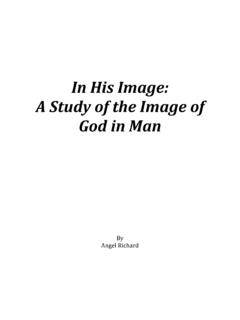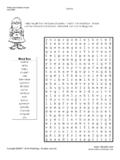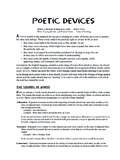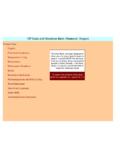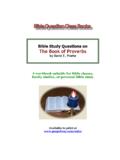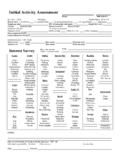Transcription of 1 John: A Study - Seven Rivers
1 1 john : A Study Angel Richard 2 January 2006 The most helpful glasses I put on as I began this Study came from a word picture out of David Jackman s commentary. Regarding john s style of writing he says, The links between ideas are not always clear and the transition is usually very have found the image of a spiral staircase the most helpful. As you climb the central staircase in a large palace or stately home, you see the same objects or paintings from a different angle, often with a new appreciation of their beauty. It is rather like that with the great truths john is concerned to state and revisit in the letter. The view gets more wonderful as you climb and the heavenly light shines more and more clearly until you reach the top. Page 18 This is the way I studied I john and in Lessons 4-6 the idea of the spiral staircase framed the structure of the lessons.
2 Within those lessons and again in Lesson 7 you will see the three tests repeated. john offers these test as the way in which the church can answer their questions about themselves and those who have left. Enjoy the climb! It is a book with depth and simplicity. Stay long enough to gaze as you work through the lessons. Do not rush or you might miss the opportunity to draw near to the Father, which is what I pray for everyone who jumps into I john . Go be with your Father who loved us first. Gaze at the Son who atoned for our sins. Finally, cry out for the Spirit to move our hearts and open our eyes. Father, unless You move us we will not be moved. Unless You come we will never be different. Give us You for that is all we long for! Angel Richard 3 Contents Homework Option # 1 Bible Reading Homework Option #2 Meditation Questions Homework Option #3 Study of I john Lesson 1 Who s Who and What s What?
3 I john 1-5 Lesson 2 Why Write? I john 1-5 Lesson 3 The Word of Life I john 1:1-4 Lesson 4 God is Light and His Children Walk in Light I john 1:5-2:27 Lesson 5 God is Righteous and His Children Do What is Right I john 2:28-4:6 Lesson 6 God is Love and His Children Love One Another I john 4:7-21 Lesson 7 You Can Know I john 5:1-21 Lesson 8 Stepping Back To Gaze At The View Appendix I john 1-5 (New International Version) Historical Background Article Understanding Gnosticism Article The Person and Work of Christ chart Recommended Commentaries: David Jackman, The Message of john s Letters, The Bible Speaks Today Series, InterVarsity Press 4 john Stott, The Letters of john , The Tyndale New Testament Commentaries, William B. Eerdmans Publishing Company 5 Homework Option #1 Reading the Bible with Theological Eyes God gave us the Bible so that we could know Him.
4 The main purpose of the Bible is to reveal God to us through story, history, biography, poetry, prophecy, and the apostles teachings. God is the true hero of the Bible, and we understand it best when we look first for Him. Thoughtful Bible reading is essential for every Christian who is serious about her (or his) relationship with God. God doesn t want a one-sided relationship with us. He calls us to work at knowing Him by spending time in His Word and by wrestling to understand what He wants us to know. But many of us don t know how to read or where to begin. Here are some suggestions to help both the beginner and the seasoned reader dig deeper into God s Word. Three simple questions transform our reading of the Bible from a hunt for some comforting morsel to get us through the day into an active enriching search for God: 1. What does this tell me about God?
5 This question focuses my thoughts on God first, rather than on myself. You ll be surprised at what you discover when you spend time trying to understand what God is revealing about Himself. What does God say directly about Himself? What do God s prophets tell His people about God? How does God look through the eyes of Abraham, Ruth, David, or Peter? 2. What does this tell me about myself? God know everything about me the good, the bad and the ugly. Yet He will never turn away or reject me. His intimate knowledge of me opens the door for me to be honest before Him about my sin, my weaknesses and failings, my hopes and fears. And it is in the light of His character that I will begin to see myself more clearly and learn in deeper ways how much I need Him and His redemptive work in my life. 3. What difference does it make? God never reveals Himself simply to satisfy our curiosity or even simply to give us greater insight into ourselves.
6 We are His image bearers, and He wants for us to be like Him. So I must always probe and ask why He wants me to know these things about Him and about me. What difference does this make in how I trust Him, how I see my circumstances and how I relate to others? God is a revealing God. He does not hide in the Scriptures. He wants us to know Him. His Holy Spirit specializes in helping us understand and know God better through His Word. So 6 as you read and Study the Bible, expect God to open your eyes and help you know Him better. Resource form The Whitby Forum ( ) 7 Bible Reading Schedule for 1 john Lesson 1 I john 1:1-4 Lesson 2 I john 1:5-2:11 Lesson 3 I john 2:12-27 Lesson 4 I john 2:28-3:3 Lesson 5 I john 3:4-4:6 Lesson 6 I john 4:7-21 Lesson 7 I john 5:1-21 Lesson 8 I john 1-5 Review *AS you have time, read and re-read I john in one sitting so that as you are focusing on one section you are still able to keep the whole letter in mind.
7 8 Lesson One Who s Who and What s What? I john 1-5 ..before we can appreciate its (I john ) message fully, or feel the force of its searching analysis in our lives, we need to know a little about why these letters came to be written and who their author was. David Jackman, The Message of john s Letters Goal: To understand I john in its original historical context. FIND IT If we were to reconstruct the context of I john as a drama there are three main characters. The author and the recipients hold a staring role but there is another group written of that holds just as much weight. Read through I john in its entirety noting every reference to the author, the recipients and the other group. There is a copy of the NIV version of I john located in the Appendix for your use. The space is provided for you to write down your insights.
8 The Author 1. What does the author tell you about himself? 2. What s his relationship with the readers? 3. Does he name himself? 4. Can you discern where is he? 9 The Recipients 1. Who are they? 2. What is their situation? 3. What do you learn about them? The Other Players 1. Who are they? 2. What names are used to describe them? 3. What insight do you get from the text that helps you paint a fuller picture of them? 4. What have they done or are doing? 10 1. Read the notes provided in the Appendix entitled Historical Background. Write down anything that helps you understand the historical setting and the people involved. 2. Read the Introduction section in the commentary of your choice regarding the historical background. Note anything that helps you see their world clearly. 3.
9 In a paragraph or two, summarize this lesson by answering these two questions: What did you learn about the author and his relationship with the recipients? What is going on at the church that received this letter? APPLY IT 1. In our churches today how would I john be insightful? In what circumstances would we turn to john for help? These are questions to press home the context in which this letter was written. 2. What stood out to you as you read through I john this week? 11 TALK ABOUT IT If your Study only turns into an academic adventure you miss the opportunity to interact with your great God and Father. Each lesson gives you a place to respond to the input you get from the Holy Spirit via God s word. Study is meant to press us to dialogue. In fact, all Study is a dialogue as we ask God to come in the fullness of His Spirit.
10 With that in view, take 5-10 minutes to journal with your Father about the things you saw in this lesson. 12 Lesson Two Why Write? I john 1-5 The internal evidence furnished by the letters discloses not only the diabolical origin and damaging activity of the false teachers, but to some extent the nature of the perverted system as well. john Stott, The Letters of john Goal: To understand why john wrote this letter. What were the questions he was answering and the issues he was addressing? In the last lesson we gave our attention to the historical context that prompted this letter. This lesson focuses on the theological context of john s writing. Theological means the things pertaining to the understanding of God. Begin to ask the question, What truths were being assaulted with regards to Christianity that compelled john to put pen to paper?
